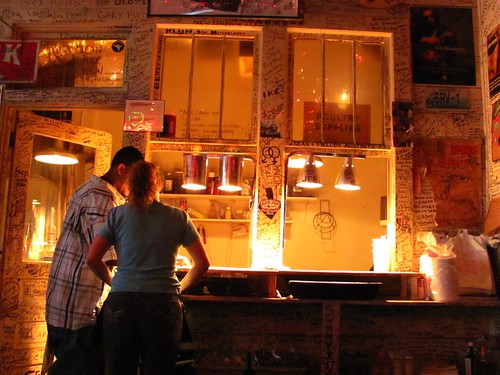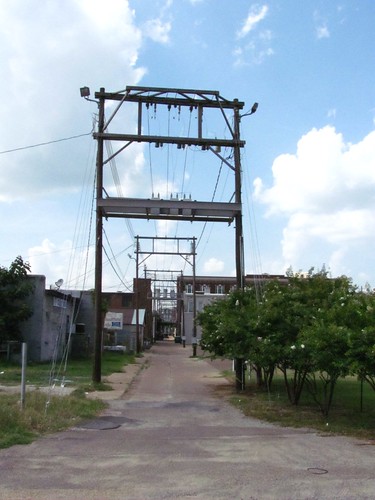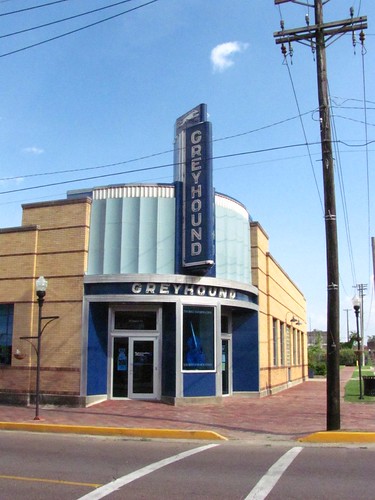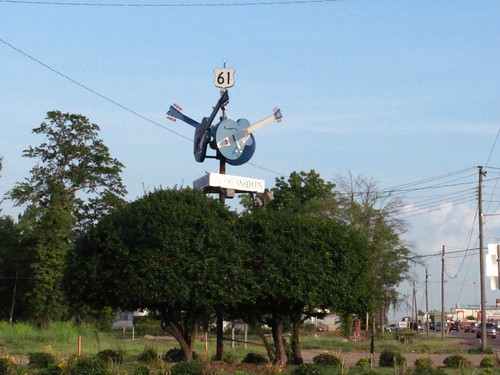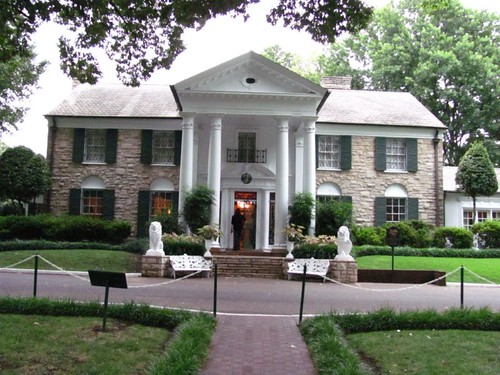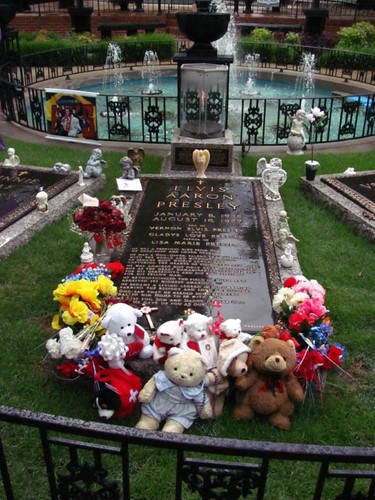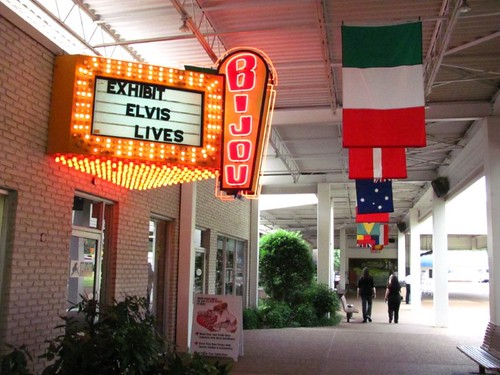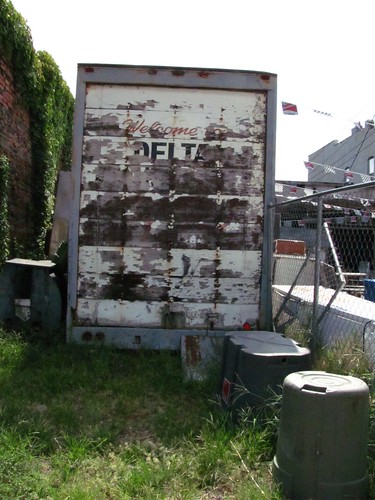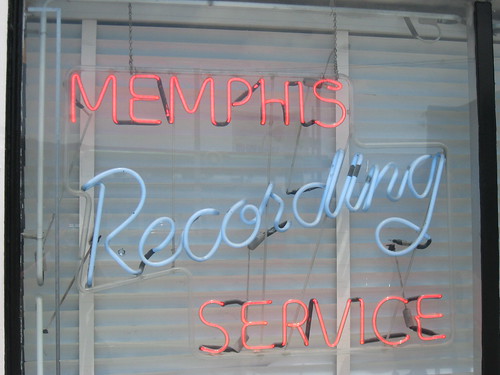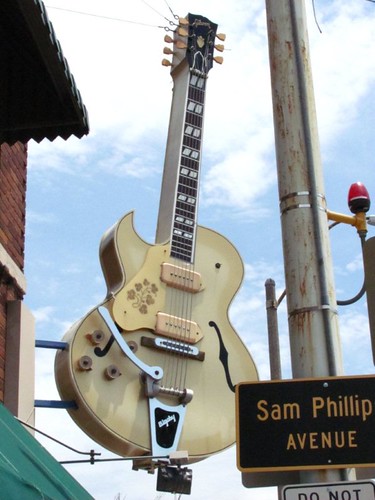After our visit to the Delta Blues Museum, we stopped at the beautifully restored Greyhound station in Clarksdale, which now serves as its visitor information center, and one of the friendly gentlemen on duty gave me a helpful map locating blues-relevant sites around town. Using it, we headed up 4th Street so I could photograph the historic marker for Eddie James “Son” House, Jr. (not to be confused with his Mississippi Blues Trail marker, which is in Tunica).
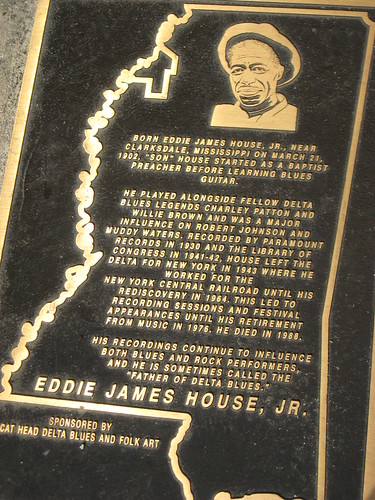
Nothing on the marker indicates that its placement is particularly relevant to House’s history, but standing on that street for a few minutes gave a little insight into at least two of the “classes” that populate Clarksdale. Son House’s marker is implanted in the sidewalk in front of a folk art gallery where no one pays you much mind unless you look like you have money to spend, while just down the street, a seemingly schizophrenic man was shouting about something very important to him. These moneyed, white-owned establishments feel heartbreakingly out-of-place in Clarksdale. Though I am clearly operating from an outsider’s limited view, I had to wonder how the relationship between the rich whites and poor blacks plays out as they sit stacked on top of each other in this small town, one just trying to get through while the other exploits the musical history of the area that they could only tangentially be linked to.
Back in the car, I failed to locate Ike Turner’s childhood home (he will be getting his Mississippi Blues Trail marker on August 6) and waffled for a bit on our next destination: back to Oxford to pass out in the motel room (the heat of Mississippi in July great reduces the constitution of us delicate Northerners) or one last stop at the Riverside Hotel. Feeling it would be silly to be in Clarksdale and not at least see the place where Bessie Smith died after a car accident when the Riverside was a hospital and where everyone from Muddy Waters to the Staple Singers stayed once the building was converted to a hotel, I guided the car down Sunflower Avenue.

Parking next to the hotel’s Mississippi Blues Trail Marker, the intent was to just snap a couple of pictures and go back “home”. The Riverside Hotel looks like an unassuming house from the road. If not for the marker and the small, hand-painted “Riverside Hotel” sign, which also proclaims it the “Home of the Delta Blues”, you might not even realize it was a hotel. I smiled at a wary-looking man who was also approaching the hotel and took a photo of the building. The man, dressed in white T-shirt, blue jeans and a baseball cap, engaged me in conversation, but slowly. After a moment, he told me he was the owner of the hotel. I remarked on the history contained in the hotel and after a little more conversation, he asked if I’d like to see the inside.
(Later, we decided that the man, Frank “Rat” Ratcliff, was sizing me up to see if I was a real or “fake” – as he would later characterize one pair of people he did not let rooms to – blues fan. It seemed I had dropped the correct combination of names to give me the keys to the kingdom.)
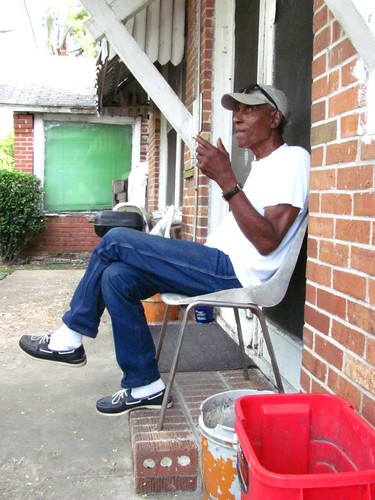
Photo by Jennifer
Not about to pass up the opportunity, I gathered my companions. Rat gave us a little more history of the place – how he had inherited the hotel from his mother, Mrs. Hill, and how John F. Kennedy, Jr., had once stayed at the hotel, an event I had just read about in Francis Davis’ The History of the Blues – before taking us inside. The front hall is covered in framed photos and news clippings, like a mini-museum of the Riverside and its famous patrons. Rat informed us that this front portion of the hotel had been the men’s ward when the building was a hospital and that the doors to the rooms were the originals from the hospital. A set of stairs leads down to the basement level where Ike Turner and his band had written and rehearsed “Rocket 88” before travelling up to Memphis to record the landmark song at Sun Studio.
Soon we came upon the Bessie Smith room, which is probably the largest of the rooms and is famously not available to let. Portraits of Smith, some painted by former patrons of the hotel, hang above the bed and rest on the bed and on a table outside of the door. A photo of Mrs. Hill also hangs on the wall.

Photo by Jennifer
Rat showed us each room, noting a famous name of someone who had stayed in that room at one time. The Muddy Waters room, the John Lee Hooker room (appropriately, the mattress in this room has “the most bounce”), the rooms where the original Blind Boys of Alabama stayed, the room where Sam Cooke stayed, etc. But as Rat showed us into each homily-appointed room, encouraging us to step in and look around, I realized it wasn’t these former famous residents that made Rat most proud. What is important to him is that people who stay at the Riverside see it as a home-away-from-home. In any dresser in any room, you can find the personal belongings of someone who has stayed in that room before. “They leave their things in the drawer,” Rat says, “and they know they’ll be there when they come back.” When a room is unoccupied, its key stays in the door lock with no fear of being snatched. And Rat doesn’t assign rooms. When you book a room at the Riverside, you can choose any unoccupied room you want (save the Bessie Smith room, of course).

The Muddy Waters Room
When we reached the end of the hall, seeing how we had all partially melted during our tour, Rat invited us to sit in the air-conditioned front room.* In the tradition of older Southern men, Rat likes to talk, and for the next hour and a half, we sat as Rat told us about whatever was on his mind. We learned that Rat had quit drinking a few years prior, that he was working on cutting out smoking (you will frequently see him with a cigarette in his hand, but it will often remain unlit) and that he had a pacemaker. He told us about the club he used to run in
the basement of the Riverside and the copious amounts of liquor he would bring in from Arkansas for the Christmastime patrons of the club. We learned that his daughter Zee was leaving a less-than-ideal job to help Rat run the Riverside and eventually take it over. She’ll be bringing in a computer so that the hotel can tap into the internet and take reservations online. We learned about best business practices and Rat’s intention to transfer his church membership from one in which the preacher was lining his own pockets to one that was community-minded.
Learning that Cam’s hometown in Australia was the same as one of the Riverside’s regular visitors, a blues musician called Sugarcane Collins, Rat instructed Cam to find Sugarcane when he returned home, tell Sugarcane he had a message for him from someone in the States and let loose with a string of expletives. Rat assured Cam that Sugarcane would know who the message was from.
After spending two hours with Rat, it was time for our party to head back to Oxford and let Rat check in a couple of new visitors. It’s difficult not to develop warm feelings for Rat over the course of conversation, and I wondered how awkward it would be if I hugged him goodbye. Happily, Rat was already a step ahead of me and gave warm hugs to both Jennifer and me while giving Cam a hearty handshake (and reminding him of the message for Sugarcane Collins).

When I think of Mississippi now, there are three things that stand out in my mind:
- Long, quiet roads flanked by kudzu-covered trees
- sweet tea
- Rat
When I think about these things, I feel a pang in my heart. Coming back up to Ohio, I found myself resentful of the fact that I couldn’t just jump in the car and be in Oxford or Clarksdale or Memphis, Tennessee, within an hour. I know I will return there soon (possibly even as soon as Christmastime), and at some point, I may even return for longer than a visit.
Here’s a clip of one of the Riverside’s former patrons, the soulful Sonny Boy Williamson.
[youtube=http://www.youtube.com/watch?v=AGUGXOxs6p0]
*The individual rooms are also air-conditioned, and Rat will switch on the air for your room when he knows you’re on your way.
